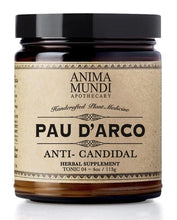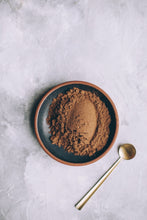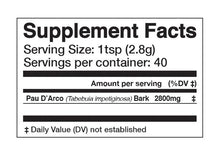Pau D Arco - IPE ROXO - Tahuari aka Tree of Life
Main Potential Actions: Anti-Viral, Anti-Candidal, Blood Builder, Reproductive Balancer, Skin Repair
Use throughout History
"Pau d'arco has a long and well-documented history of use by the indigenous peoples of the rainforest. Indications imply that its use may actually predate the Incas. Throughout South America, tribes living thousands of miles apart have employed it for the same medicinal purposes for hundreds of years. They use the bark to treat many different conditions and as a tonic for the same strength and vigor it puts into their bows. Pau d'arco is recorded to be used by forest inhabitants throughout the Amazon for malaria, anemia, colitis, respiratory problems, colds, cough, flu, fungal infections, fever, arthritis and rheumatism, snakebite, poor circulation, boils, syphilis, and cancer."
In South American herbal medicine, it is considered to be astringent, anti-inflammatory, antibacterial, anti-fungal, and a laxative. It is used to treat ulcers, syphilis, urinary tract infections, gastrointestinal problems, candida and yeast infections, cancer, diabetes, prostatitis, constipation, and allergies. In North American herbal medicine, pau d'arco is considered to be analgesic, antioxidant, anti-parasitic, antimicrobial, anti-fungal, antiviral, antibacterial, anti-inflammatory, and a laxative, as well as having anti-cancerous properties. It is used for fevers, infections, colds, flu, syphilis, urinary tract infections, cancer, respiratory problems, skin ulcerations, boils, dysentery, gastrointestinal problems of all kinds, arthritis, prostatitis, and circulation disturbances.
Properties/Actions Documented by Research:
analgesic (pain-reliever), antibacterial, anticancerous, anticandidal, antifungal, anti-inflammatory, antileukemic, antimalarial, antiparasitic, antitumorous, antiviral, insecticidal
Other Properties/Actions Documented by Traditional Use:
anti-allergy, anti-ulcerous , anticoagulant (blood thinner), anti-dysenteric, antioxidant, anti-rheumatic, antivenin, astringent, cardiotonic (tones, balances, strengthens the heart), hepatotonic (tones, balances, strengthens the liver), immunostimulant, laxative
Cautions: In excessive amounts, it may cause gastrointestinal upset or nausea.
-- LONG FORM --
Documented Clinical Research:
The chemical constituents and active ingredients of pau d'arco have been well documented. Its use with (and reported cures for) various types of cancers fueled much of the early research in the early 1960s. The plant contains a large amount of chemicals known as quinoids, and a small quantity of benzenoids and flavonoids. These quinoids (and, chiefly, anthraquinones, furanonaphthoquinones, lapachones, and naphthoquinones) have shown the most documented biological activity and are seen to be the center of the plant's efficacy as an herbal remedy. In the 1960s, plant extracts of the heartwood and bark demonstrated marked antitumorous effects in animals, which drew the interest of the National Cancer Institute (NCI). Researchers decided that the most potent single chemical for this activity was a naphthoquinone chemical named lapachol and they concentrated solely on this single chemical in their subsequent cancer research. In a 1968 study, lapachol demonstrated highly significant activity against cancerous tumors in rats.
By 1970, NCI-backed research already was testing lapachol in human cancer patients. The institute reported, however, that their first Phase I study failed to produce a therapeutic effect without side-effects - and they discontinued further cancer research shortly thereafter. These side-effects were nausea and vomiting (very common with chemotherapy drugs) and anti-vitamin K activity (the main concerns over which caused anemia and an anticoagulation effect). Interestingly, other chemicals in the whole plant extract (which, initially, showed positive antitumor effects and very low toxicity) demonstrated positive effects on vitamin K and, conceivably, compensated for lapachol's negative effect. Once again, instead of pursuing research on a complex combination of at least 20 active chemicals in a whole plant extract (several of which had antitumor effects and other positive biological activities), research focused on a single, patentable chemical-and it didn't work as well. Despite NCI's abandonment of the research, another group developed a lapachol analog (which was patentable) in 1975. One study reported that this lapachol analog increased the life span of mice inoculated with leukemic cells by over 80%. In a small, uncontrolled, 1980 study of nine human patients with various cancers (liver, kidney, breast, prostate, and cervix), pure lapachol was reported to shrink tumors and reduce pain caused by them - and three of the patients realized complete remissions.
The phytochemical database housed at the U.S. Department of Agriculture has documented lapachol as being antiabscess, anticarcinomic, antiedemic, anti-inflammatory, antimalarial, antiseptic, antitumorous, antiviral, bactericidal, fungicidal, insectifugal, pesticidal, protisticidal, respiratory depressant, schistosomicidal, termiticidal, and viricidal. It's not surprising that pau d'arco's beneficial effects were seen to stem from its lapachol content. But another chemical in pau d'arco, beta-lapachone, has been studied closely of late-and a number of recent patents have been filed on it. It has demonstrated in laboratory studies to have activities similar to lapachol (antimicrobial, antifungal, antiviral, antitumorous, antileukemic, and anti-inflammatory), with few side-effects. In one of these studies on beta-lapachone and other quinones in pau d'arco, researchers reported: "Because of their potent activity against the growth of human keratinocytes, some lapachol-derived compounds appear to be promising as effective antipsoriatic agents." In a 2002 U.S. patent, beta-lapachone was cited to have significant anticancerous activity against human cancer cell lines including: promyelocytic leukemia, prostate, malignant glioma, colon, hepatoma, breast, ovarian, pancreatic, multiple myeloma cell lines and drug-resistant cell lines. In yet another U.S. patent, beta-lapachone was cited with the in vivoability to inhibit the growth of prostate tumors.
The main plant chemicals in pau d'arco include: acetaldehydes, alpha-lapachone, ajugols, anisic acid, anthraquinones, benzoic acids, benzenes, beta-lapachone, carboxaldehydes, chromium, chrysanthemin, dehydro-alpha-lapachone, dehydroisolapachone, deoxylapachol, flavonoids,furanonaphthoquinones, hydrochlorolapachol, 2-hydroxy-3-methyl-quinone, 6-hydroxy-mellein, iso-8-hydroxy-lariciresinol, kigelinone, lapachenol, lapachenole, lapachol, lapachones, menaquinones, 4-methoxyphenol, naphthoquinones, paeonidin-3-cinnamyl-sophoroside, phthiolol, quercetin, tabebuin, tectoquinone, vanillic acid, vanillin, veratric acid, veratric aldehyde, and xyloidone.
~ Leslie Taylor, ND
- - -
Amount per container: 4oz (113g) Fine Powder
Amount of servings: 40 servings (using 1 tsp per serving)
Directions: 1-2 tsp in your tea, soup, broth. For a stronger dose simmer for 20min, strain and enjoy.
As a tea, steep 1-2 tsp, in a cup of boiling water for 15 minutes and enjoy.
Dosage always depends on the conditions you wish to treat. For acute symptoms we recommend 2-3x day. For daily toning, we recommend 1-2x day. Consume before meals, or 1hr after meal.
*These statements have not been evaluated by the FDA. This product does not intend to treat or prevent any any disease.






